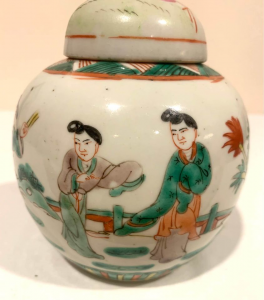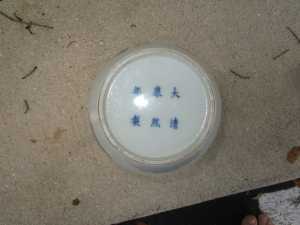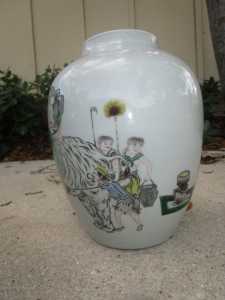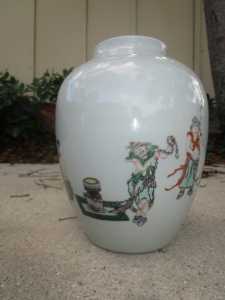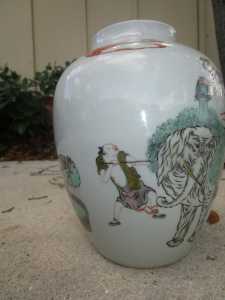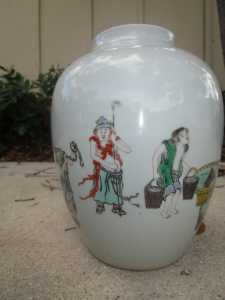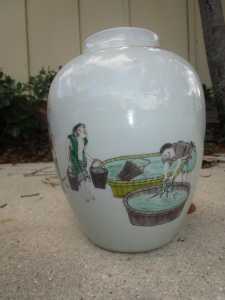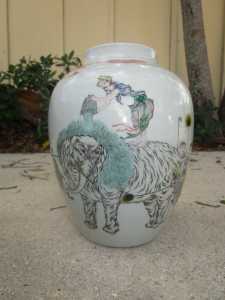The Chinese and Asian Art Forum. For Fans, Collectors and Dealers.
 Basic Rules For the BidAmount Asian Art Forum: Talk about whatever you want. You can even discuss and offer things that are for sale if they are authentic. Maximum image file size per post is 2 MB. Images of 700pxl x 700pxl are optimal if saved at a medium resolution. Be respectful of others and enjoy yourself. Click the YouTube link for a brief tutorial on using the forum. You can also EMBED Videos by cutting and pasting from You-Tube, Vimeo etc.
Basic Rules For the BidAmount Asian Art Forum: Talk about whatever you want. You can even discuss and offer things that are for sale if they are authentic. Maximum image file size per post is 2 MB. Images of 700pxl x 700pxl are optimal if saved at a medium resolution. Be respectful of others and enjoy yourself. Click the YouTube link for a brief tutorial on using the forum. You can also EMBED Videos by cutting and pasting from You-Tube, Vimeo etc.
NOTE: To post an item or add a new post, click open the category title from the FORUM LIST, and CLICK the Blue ADD TOPIC button.
@greeno107 I thought the drawing was done with care. I thought the figures seemed to be done in the same style as Kangxi pieces when I compared. Same types of faces and garb. I thought the colors could all be found in similar tones on true Kangxi examples. I found similar borders as what can be found on some Kangxi examples. I saw examples of Kangxi pieces that had very similar looking leaves and trees, etc. Clearly I am missing quite a lot, but other than the fact that someone is sweeping the floor and there is a crackle glaze ground nobody has said exactly what is so bad about this one and I would like to know.
I just want to know why the woman is doing the work why the guy next to her with his broom is just standing around. Lol
@lotusblack Which brings up an important question: does Giovanni still have to give me a million dollars if I find an example with a genuine Kangxi man sweeping the floor, or must it be a female? I will be looking for examples of both just in case.
@johnshoe So, I can understand if you felt the design was Kangxi like....it is Kangxi like in that it has a palace like scene, and it is famille verte enamels, also associated with Kangxi. Again, from a technical standpoint, I think you did okay, except for the crackle brownish porcelain. My first post was not too critical, was it?
However, the excitement of finding an old Chinese vase (and, yes, I think 120 years is pretty old) gets the adrenaline pumping. Once the piece is in your hands (and nobody else can buy it from under your nose), THEN it is time to be self-critical. What about the piece doesn't add up?
Aside from the crackle porcelain, you thought the rendering was done with care is where your experience hindered you.
There is a certain sophistication in genuine Kangxi works. The scene in this vase is loose and whimsical... not what I would consider to be Kangxi taste.
Take a look at the horses in this example.
https://www.christies.com/lot/lot-a-rare-large-famille-verte-baluster-jar-6276550/?
Just FYI 19th century ginger jars are hot commodity in China right now.
@johnshoe So, your small ginger jar is the very bottom of the spectrum of 19th-early 20th c. work copying the Kangxi style. The lamp is maybe a 6 out of 10.
Here is a small vase I sold at the Miami Beach antique show about 5 years ago....I would argue a 10 out of 10 for 19th c. Kangxi copies. I think I've seen some article on it floating around on Google.
Washing of the elephant is a famous motif from the late Ming into the Kangxi.
@greeno107 Interesting. I would have thought that jar of yours was a republic era piece.
@greeno107 Do you continue to think the lamp is circa 1890's Kangxi revival? If so, I do not understand why people say 285 is too large a price. Is the fact that someone lamped it without drilling a good sign that someone valued the lamp? I see what you mean about the horses being less naive on your jar, but I continue to think the faces on the lamp were well drawn. I can understand the fact that Kangxi needs to have a bright white base and not brown looking crackle, but that elephant looks naively drawn to me. In any case, this is interesting. Sharon
Greeno is absolutely right. I repeated this many times already, the painting style comes FIRST!
It is the painting style that tells you, at first glance, and even at a distance: Kangxi/not Kangxi, Ming/not Ming, etc.
After that, closely inspecting, all the technical details are just confirming what you already knew.
I said it many times, and I also said that those shortcuts, the face, the brownish edge, etc etc, are, for the not experienced people, more dangerous than helpful. Yes, “because the blue is correct, then it is genuine”. Nope! ALL types of blues can be found during Kangxi. Even the blurred blue of the Japanese ware.
There is not a single detail that, taken alone, is a sure tool for dating a piece. Even more today.
Educate the eye on the style. An Italian painting of the 15th century is different from those of the 15th century, which in turn is different from those of the 16th century, and so on. It is not the type of colors that tells the expert the correct period. It could confirm, but nothing more.
BTW that vase is horrible. I will correct my previous comment: I would not pay ONE dollar. For what?
Giovanni
@clayandbrush What about the style informs you that something is nice or not? Are you able to give any descriptive terms that can describe in more detail what you are talking about and what you look for? For example, if you were to finish the following sentence what would you say: "A good Kangxi famile verte baluster vase should be/have __________ "
@sharonp So, I think the lamp vase (original post object) should be considered Kangxi revival because it's decoration is based upon Kangxi style, and was created during the period of the Kangxi revival period (late 19th c.). Quality of rendering varied from low to high, some very loose interpretation of Kangxi style, while others were near exact matches.
The mouth of the lamp vase appears to have been cut off, so that reduces the value of this quality vase to just about zero. I'm not sure how it is drilled from the photos, but if it is drilled it's worth half it's value....so half of zero....zero.
A lamp that runs the wiring outside the vessel can be an indication of quality, but not always. There are a lot of 20th c. Guanyin blanc de chine figures worth about $20 that have the wire externally, so I don't recommend that you consider how it is lamped as a clue to the quality of the piece.
The elephant is deliberately drawn naively, so it does not follow the same rule as to how the horses were drawn.
In the Ming to Kangxi, there was nearly zero people in China that had first hand knowledge of what an elephant actually looked like. So, during this period, renderings of elephants were made based upon word of mouth, so they were made with fanciful characteristics like veiny leaf ears, toes that stick out, sometimes extra tusks, really narrow trunks, and extreme wrinkles.
By the Qianlong period, knowledge of what elephants really looked like had become common knowledge, so elephants were rendered more anatomically correct.
In the case of my late 19th c. vase, the artist recreated the how he believed a Kangxi style elephant should look... not exactly correct to the Kangxi, but it is hard to unlearn what an elephant looks like.
As for the faces of the people.... we disagree...no problem.
This discussion brings up a topic I have been thinking about over the past six months as I have looked at so many of these “Is this old,…good,…valuable…?” requests. What keeps going through my mind is how does one develop “an eye” for quality when judging Asian antiques.
This is going to sound simple minded, but here goes…STOP LOOKING AT BAD THINGS, START LOOKING AT GOOD THINGS! At the beginning, choose a class of items that bring you the most joy. Ceramics, jades, bronzes, paintings, whatever they are seek out the best examples in museums, quality specific dealers, and specialized auctions. Unless you live in New York, London, or Hong Kong, expect this viewing/handling process to take years. Arrange some of your vacation time to accommodate these activities. Become known to curators in Asian departments at notable museums, contact professors at universities with Asian fine arts departments, and make friends with dealers in quality Asian antiques.
Until one develops an eye for quality, no notebook listing a bunch of rules to separate the good from the bad will get you where you want to be. I have the greatest admiration for those forum members who reliably respond to these unending requests for information regarding objects that in my eye are painful to view even as photographs.
Thanks for visiting "The BidAmount Asian Art Forum | Chinese Art"
If you sell on eBay, or have a shop feel free to post images and descriptions and links.
Check back often for discussion about the latest news in the Chinese art and antique world. Also find out about the latest Asian art auctions at Sotheby's, Christie's, Bonhams and Tajans.
Auction results for: fine porcelain, ceramics, bronze, jade, textiles and scholar's objects. As well as Japanese, Thai, Vietnamese and other Asian cultures.
Thank you,
Peter Combs
Topics and categories on The BidAmount Asian Art Forum | Chinese Art
Kangxi vases, Kangxi dishes and chargers, Kangxi ritual pieces, Kangxi scholar's objects, Qianlong famille rose, Qianlong enamels, Qianlong period paintings, Qianlong Emporer's court, Fine porcelain of the Yongzheng period. Chinese imperial art, Ming porcelain including Jiajing, Wanli, Xuande, Chenghua as well as Ming jades and bronzes.
The BidAmount Asian Art Forum | Chinese Art
A free Asian art discussion board and Asian art message board for dealers and collectors of art and antiques from China, Japan, Korea, Thailand, Cambodia, Vietnam and the rest of Asia. Linked to all of the BidAmount Asian art reference areas, with videos from plcombs Asian Art and Bidamount on YouTube. Sign up also for the weekly BidAmount newsletter and catalogs of active eBay listing of Chinese porcelain, bronze, jades, robes, and paintings.
The art of calligraphy - and for the ancient Chinese it certainly was an art - aimed to demonstrate superior control and skill using brush and ink. Calligraphy established itself as one of the major Chinese art forms during the Han dynasty (206 BCE - 220 CE), and for two millennia after, all educated men were expected to be proficient at it.
The Museum’s collections of Asian art span nearly five millennia and encompass the cultures of China, the Himalayas, India, Japan, Korea, and Southeast Asia. In 2007, the Museum launched an initiative to create dedicated galleries for the collection, beginning with a gallery for the arts of Korea ...
Chinese art is full of symbolism, in that artists typically seek to depict some aspect of a totality of which they are intuitively aware.
China Online Museum is the finest online museum of Chinese art. It features Chinese calligraphy, painting, ceramics, bronzes, carving, and other artworks.
Chinese Ceramics & Works of Art. Overview Upcoming auctions Contacts Auction results ... Christie’s sales of Chinese ceramics and works of art showcase centuries of Chinese history. Held throughout the year in London, New York, Paris and Hong Kong, they attract a wide audience of collectors and connoisseurs vying for pieces as diverse as ...
Explore Asian Art Week. Contact the Specialist Department. Chinese Paintings ... Senior Specialist, Head of Sale. [email protected]. Tel:+1 212 641 5760. Bid in-person or online for the upcoming auction:Fine Chinese Paintings on 10 September 2019 at New York. Bid in-person or online for the upcoming auction:Fine Chinese Paintings on 10 ...
Discover an abundance of must-see art from all corners of a vast continent at Christie’s NY Asian Art Week. From contemporary classical and Chinese paintings to works with exemplary provenance from the Art Institute of Chicago, our Rockefeller Paza galleries will be full of ancient treasures and contemporary masterworks in a salute to the vibrant arts of Asia.
Sold to benefit The Art Institute of Chicago’s Asian Art Acquisition Fund, the sale features 84 lots with a focus on Ming and Qing porcelains, and offers a rare insight into the taste for collecting Chinese ceramics and works of art in the Midwest from the end of the 19th century through the 1980s. Highlights include two Wanli wucai garlic-head vases, a Qianlong mark and period, blue and ...
Specialist, Chinese Paintings, Christie's London Dr Malcolm McNeill is a Specialist in Chinese Paintings at Christie’s, based in London. He previously worked as an assistant curator of the Chinese collections and the Victoria and Albert Museum in London, as a researcher at the British Museum, and as a translator and tour guide at the National Palace Museum in Taipei.
The Christie's Education 2020 Conference: The Chinese Art Market 18 Jun 2019 Christie’s Education is delighted to announce our first international academic conference in Asia which will take place in Hong Kong from 26-27 November 2020 at the Hong Kong Convention and Exhibition Centre and will run in parallel with Christie’s Hong Kong Autumn Auctions.
The summer Chinese Art sale in Hong Kong will feature works of art from several private collections, including Qing porcelains and textile from the collection of the legendary Chinese art dealer A. W. Bahr (1877–1959), fine gilt bronze Buddhist sculptures from an old Hong Kong collection, an East Asian collection of Qing dynasty wine cups and jades, and a Japanese collection of Song ceramics ...
Sotheby's Chinese Works of Art Department holds two auctions each year in London, New York, Hong Kong and Paris.
Chinese Art - View Auction details, bid, buy and collect the various artworks at Sothebys Art Auction House.
With more than 340 Chinese works of art dating from the Neolithic to the Republic periods, highlights of this sale include a selection of Qing Imperial monochromes from the collection of Arnold and Blema Steinberg, early ceramics from the Art Institute of Chicago and Chinese porcelain and works of art from the collection of Henry Arnhold.
Results: Sotheby's Asia Week achieved $52.4 million in six strong auctions, exceeding pre-sale estimates. With 76.5% of lots sold and 60.3% of lots surpassing high estimates, the Asian art sales at Sotheby's indicate continued collector interest in the finest works of art from China, India and and the Himalayas.
Today's sale of Important Chinese Art will proceed as planned with sessions at 10 AM and 2 PM EDT. Sotheby's will be monitoring the weather conditions throughout the day and will be available to coordinate alternative bidding options should conditions make it difficult for clients to attend the auction in person.
Bonhams Chinese Art department is renowned for offering the finest works of art representing the richness and breadth of China's artistic heritage, particularly Imperial porcelain, white and spinach green jades, cloisonné and Buddhist art. Specialised international auctions are held globally, including London, Hong Kong and San Francisco.
Bonhams : Chinese Works of Art We use cookies to remember choices you make on functionality and personal features to enhance your experience to our site. By continuing to use our site you consent to the use of cookies. Please refer to our privacy and cookie policies for more information.
Bonhams Fine Art Auctioneers & Valuers: auctioneers of art, pictures, collectables and motor cars. We use cookies to remember choices you make on functionality and personal features to enhance your experience to our site. By continuing to use our site you consent to the use of cookies. ... Chinese Art (US) General enquiries
Bonhams : Fine Chinese Art We use cookies to remember choices you make on functionality and personal features to enhance your experience to our site. By continuing to use our site you consent to the use of cookies. Please refer to our privacy and cookie policies for more information.
Bonhams Fine Art Auctioneers & Valuers: auctioneers of art, pictures, collectables and motor cars Bonhams : Asian Art We use cookies to remember choices you make on functionality and personal features to enhance your experience to our site.
Bonhams are international auctioneers of fine Chinese and Japanese art. We specialise in rare Imperial and Export Chinese ceramics and works of art, as well as Japanese ceramics, fine and decorative works of art from the Neolithic Period to the 20th century. View on map
Bonhams Fine Art Auctioneers & Valuers: auctioneers of art, pictures, collectables and motor cars. We use cookies to remember choices you make on functionality and personal features to enhance your experience to our site. By continuing to use our site you consent to the use of cookies. ... Asian Art Bonhams. Work. 22 Queen St.
